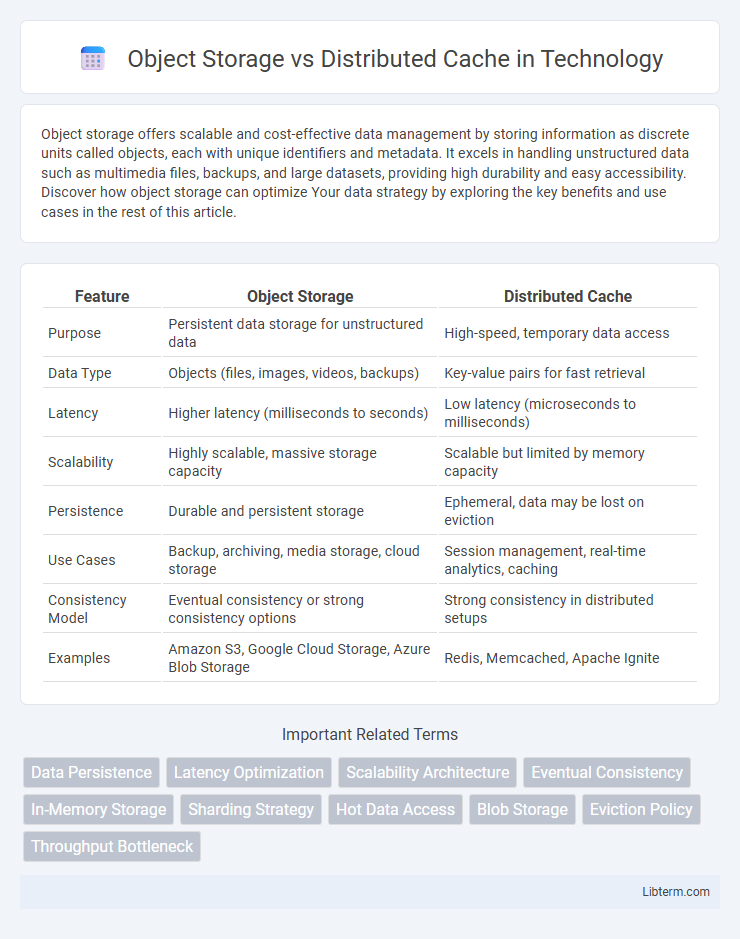Object storage offers scalable and cost-effective data management by storing information as discrete units called objects, each with unique identifiers and metadata. It excels in handling unstructured data such as multimedia files, backups, and large datasets, providing high durability and easy accessibility. Discover how object storage can optimize Your data strategy by exploring the key benefits and use cases in the rest of this article.
Table of Comparison
| Feature | Object Storage | Distributed Cache |
|---|---|---|
| Purpose | Persistent data storage for unstructured data | High-speed, temporary data access |
| Data Type | Objects (files, images, videos, backups) | Key-value pairs for fast retrieval |
| Latency | Higher latency (milliseconds to seconds) | Low latency (microseconds to milliseconds) |
| Scalability | Highly scalable, massive storage capacity | Scalable but limited by memory capacity |
| Persistence | Durable and persistent storage | Ephemeral, data may be lost on eviction |
| Use Cases | Backup, archiving, media storage, cloud storage | Session management, real-time analytics, caching |
| Consistency Model | Eventual consistency or strong consistency options | Strong consistency in distributed setups |
| Examples | Amazon S3, Google Cloud Storage, Azure Blob Storage | Redis, Memcached, Apache Ignite |
Understanding Object Storage
Object Storage efficiently manages large volumes of unstructured data by storing information as discrete objects with metadata and unique identifiers, enabling scalable and durable data retention. It excels in high-throughput scenarios such as backup, archival, and multimedia storage, with systems like Amazon S3 and Google Cloud Storage providing robust RESTful APIs for seamless access. Unlike distributed caches optimized for low-latency, transient data retrieval, object storage emphasizes persistent, fault-tolerant data availability across geo-distributed environments.
What is Distributed Cache?
Distributed cache is a high-speed data storage layer that caches data across multiple servers to improve application performance and scalability by reducing latency. It temporarily stores frequently accessed data in memory, enabling rapid read and write operations in real-time environments such as web sessions, gaming, and financial services. Unlike object storage, which is designed for long-term, persistent data storage, distributed cache excels in delivering low-latency access to dynamic data at scale.
Core Differences: Object Storage vs Distributed Cache
Object Storage is designed for storing vast amounts of unstructured data with high durability and scalability, making it ideal for backups, archives, and large media files. Distributed Cache provides low-latency access to frequently used data by distributing cached data across multiple nodes, optimizing application performance and reducing database load. The core difference lies in Object Storage's emphasis on persistent, durable storage for large data sets, whereas Distributed Cache focuses on speed and availability of transient data for real-time access.
Data Retrieval Speeds Compared
Object storage systems typically offer high scalability and durability but exhibit slower data retrieval speeds due to their design for large, persistent datasets. Distributed caches prioritize ultra-low latency access by storing frequently accessed data in-memory, significantly accelerating retrieval times. Consequently, distributed caches deliver faster data retrieval compared to object storage, making them ideal for real-time applications requiring rapid response.
Scalability and Performance Factors
Object storage offers massive scalability by distributing data across multiple nodes with built-in redundancy, making it ideal for unstructured data and large-scale storage needs. Distributed cache excels in performance by storing frequently accessed data in-memory across a cluster, significantly reducing latency and accelerating read/write operations. Scalability in distributed cache depends on cluster size and network efficiency, while object storage prioritizes durability and availability with consistent throughput at scale.
Use Cases: When to Choose Object Storage
Object storage excels in managing unstructured data at massive scale, making it ideal for use cases like backup and archival, multimedia storage, and large-scale data lakes where durability and cost-efficiency are critical. It supports high availability and eventual consistency for applications that require long-term data retention without frequent modification. Businesses should choose object storage when they need scalable, persistent storage for vast volumes of static content rather than low-latency, transient data access.
Ideal Scenarios for Distributed Cache
Distributed cache is ideal for scenarios requiring ultra-fast data retrieval with low latency, such as real-time analytics, session management, and high-throughput web applications. It excels in environments where frequently accessed data sets need to be stored temporarily close to the application layer, reducing database load and improving response times. Use cases involving frequent read-heavy workloads and dynamic content rendering benefit significantly from distributed caching solutions.
Cost Implications and Resource Management
Object storage offers cost efficiency with scalable, pay-as-you-go pricing models ideal for large volumes of unstructured data, minimizing resource overhead. Distributed cache systems typically have higher upfront infrastructure and maintenance costs due to the need for fast memory and compute resources to ensure low latency and high throughput. Effective resource management in distributed caches requires careful capacity planning and frequent tuning, whereas object storage automates much of the resource allocation, reducing operational complexity.
Security and Data Consistency
Object storage provides robust data security through encryption at rest and in transit, along with fine-grained access controls, ensuring data integrity and compliance with regulatory standards. Distributed caches prioritize low-latency access but often sacrifice strict data consistency, employing eventual consistency models that may expose stale or inconsistent data during high loads. For security, distributed caches typically lack comprehensive encryption and access management found in object storage, making them more vulnerable to unauthorized access and data tampering.
Making the Right Storage Choice for Your Needs
Choosing between object storage and distributed cache depends on access patterns and latency requirements; object storage excels in durability and scalability for large, unstructured data, while distributed cache offers low-latency data retrieval for frequently accessed information. Object storage solutions such as Amazon S3 or Google Cloud Storage provide cost-effective, persistent storage ideal for backup and archival purposes. Distributed cache technologies like Redis or Memcached deliver rapid read/write performance critical for real-time applications and session management.
Object Storage Infographic

 libterm.com
libterm.com